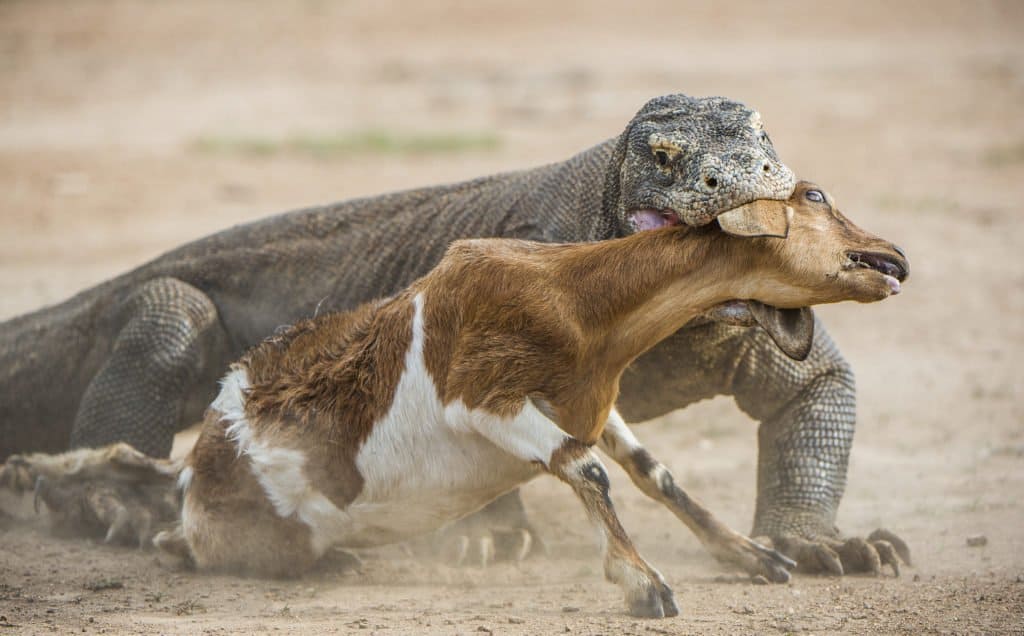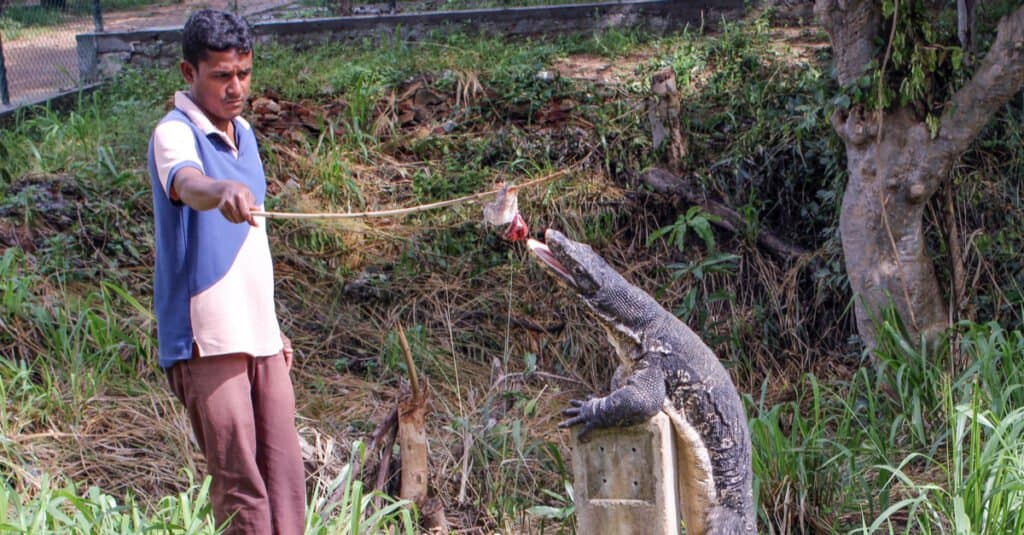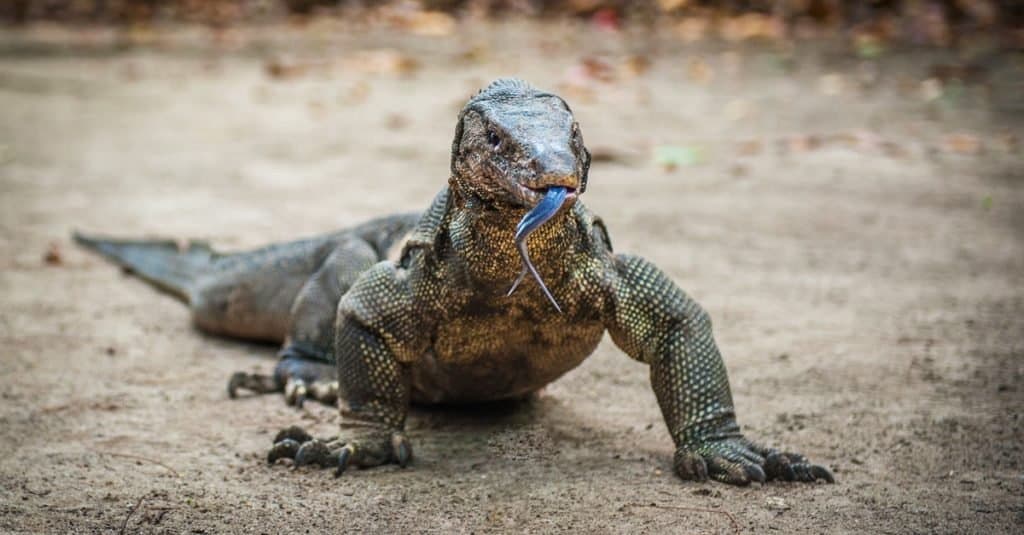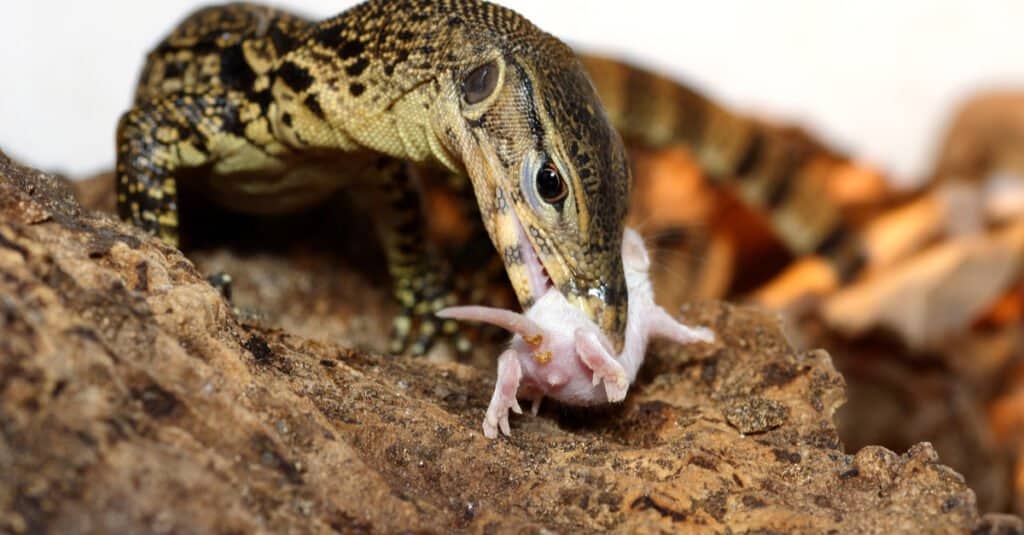
Monitor lizards are a group of large lizards that are mainly found in southern Asia, Africa and Australia. There are more than 70 species of monitor lizards including the Komodo dragon, Asian water monitor and the Nile monitor. Most monitor lizards are venomous, but is this the primary way they hunt for food? Let’s find out what their diet is and what monitor lizards eat!
With 70 species do they all have the same diet?

A Komodo dragon hunts its prey
©Sergey Uryadnikov/Shutterstock.com
The majority of monitor lizards are carnivores, with most of their food being carrion (dead animals). So although many of them are venomous that is not their primary technique for securing their meals. One species of monitor lizards, V. olivaceus, has a diet of prey and fruit and one species, V. bitatawa, eats mostly just fruit. An increasing trend that is concerning is the shift in diet of some monitor lizards, in areas with heavy human populations. One study found Asian water monitors relied heavily on human food waste. In a study in Malaysia, scientists monitored a group of 20 Asian water monitors. They were trying to see if the water monitors were responsible for raiding the sea turtle nests, but what they found was quite interesting. Yes, they were guilty of raiding the nests (21.2% of their stomach contents were turtle eggs/hatchlings), but mostly their stomachs contained human food waste (76.8%).
How do monitor lizards hunt?

A water monitor being fed
©bumihills/Shutterstock.com
There is a variety of ways that monitor lizards hunt and obtain food. Sometimes they actively hunt for food, during the day, searching for prey; other times they will wait patiently and sabotage prey as it passes by. As mentioned above, they also seek out nests of reptiles and other animals and raid the nests. The Nile monitor is a sneaky species that has been observed working together to get food. One Nile monitor will distract a female crocodile to lure her away from her nest while the other one steals her eggs!
However the most frequent technique for finding food is to search for carcasses of dead animals and feed off the remains.
What do monitor lizards eat?

A monitor lizard in Borneo
©elena_photo_soul/Shutterstock.com
Whether their prey is already dead when they find it or they hunt it themselves, the main food for monitor lizards are birds, snakes, lizards, toads, small animals, pigs, deer, cattle and water buffalo. Depending on their location, some will also eat crustaceans and turtles.
A complete list of what monitor lizards eat:
- Carrion
- Reptile Eggs
- Birds
- Snakes
- Toads
- Lizards
- Crustaceans
- Turtles
- Deer
- Cattle
- Some eat fruit and berries
Do they ever use their venom to hunt and kill prey?

A young monitor lizard eats a mouse
©Valt Ahyppo/Shutterstock.com
Yes! The Komodo dragon attacks their prey and waits for the animals to bleed out. The venom prevents the animal’s blood from clotting and so they lose too much blood to survive. For smaller animals the Komodo dragon eats the animal whole, while larger animals they will use their large claws to tear apart and feed on.
What eats monitor lizards?
The main predators of the monitor lizard are humans, wild cats and large crocodiles. Humans hunt the lizards for their skin to make leather products and for food. In many areas the monitor lizards are listed as protected.
Are monitor lizards dangerous to humans?
Monitor lizards are not out to cause trouble, they keep to themselves, but if provoked can attack, but attacks are rare. Because monitor lizards have sharp teeth and venom their bites can be hazardous. In addition their mouths are full of bacteria that can quickly cause infection so humans need to seek medical attention promptly if ever bitten.
The photo featured at the top of this post is © Sergey Uryadnikov/Shutterstock.com
Thank you for reading! Have some feedback for us? Contact the AZ Animals editorial team.






